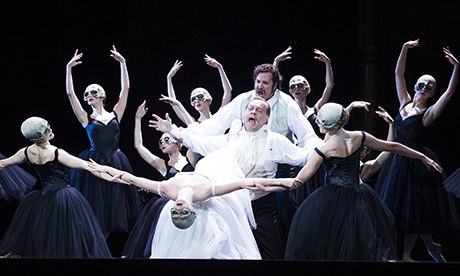
Les Vêpres Siciliennes, The Sicilian Vespers, was the first of the two operas that Verdi was to write, to a French text, for the Paris Opéra. Composed between La Traviata and the first version of Simon Boccanegra, and first performed in 1855, this ambitious attempt to emulate the success of Meyerbeer's Parisian grand operas is unquestionably mature Verdi, but it's rarely heard today. ENO put it on in 1984, conducted by Mark Elder and directed by John Dexter, but the Royal Opera's new staging is its first, and an ambitious and generally highly successful way to mark the Verdi bicentenary this month.
It's the first time, too, that a production by the much admired Norwegian director Stefan Herheim has been seen here. Together with designer Philipp Fürhofer, Herheim not only shifts the action of the opera from 13th-century, French-occupied Sicily to Paris in the year of its premiere, but locates it specifically in the Salle le Peletier, the theatre in which that first performance took place. Fürhofer's sets provide spectacular cross-sections of auditorium and stage, their geometry always shifting, and the original story of the uprising of the Sicilians against their French oppressors becomes something more complex and more intricately layered, both a study of the tension between the people and the military and an exploration of how artists are exploited by the society that creates them.
The reworking doesn't solve all the opera's dramatic problems, and it can do little about the creaky dramaturgy of the final act, when the action hangs fire for far too long, and Verdi didn't come up with enough top-quality music to justify those longueurs. But the production contains many arresting images and imaginative glosses right from the prelude, when the events that preceded the start of the opera are presented. The half-hour long ballet in the third act, which was de rigueur for shows at the Opéra at that time, is dropped (Verdi thought it dispensible too), but from the prelude onwards Herheim does take every opportunity to bring dance into the production, and André De Jong's choreography blends easily with it.
Not all the ideas are obviously successful. The significance of a winged cherub marshalling the chorus in the final act escaped me, so did the reason for having Erwin Schrott's Procida, the leader of the uprising against the French, change into a ballgown before the final massacre begins. But as a way of creating a cogent dramatic package out of what is sometimes sprawling and diffuse material it works very well indeed, and Antonio Pappano does a magnificent job in sustaining the spans of each act, seizing on every chance to bring the score to life; the choruses, especially have a blazing immediacy.
The solo performances are a bit more uneven. Both Michael Volle as Montfort, the French governor and Bryan Hymel as Henri, the son that Montfort fathered when he raped a local woman, are tirelessly superb – Volle's brooding aria at the beginning of the third act is the highlight of the whole evening. But after an impressive start in her opening aria, Lianna Haroutounian's Hélène seemed less secure and convincing as the opera went on, and Schrott's Procida is such a preening, cartoonish character that in a production with such meticulous attention to detail, one wonders whether Herheim is just sending the role up.

